To get from the Medellín airport to the city, you travel 15 miles, 5 of which go through the second-longest tunnel in Latin America, the Túnel de Oriente. In the tunnel, there are signs imploring people to not slow down. The tunnel seemed to go on forever as we zoomed through it, but shortly after its end, there it was, the city, down below. Off to the left, over the guard rail, you can see the mountains that create the Valle de Aburrá and the brick houses crawling up its slopes. The view is stunning. It is one of the things I liked most about Medellín. Anywhere there is higher ground in the city, you can see the mountains dotted with dwellings. The metro that runs through Medellín, north to south, and east to west, was one of the best places for a daytime view. Rooftop bars were the perfect place to see the mountains twinkling at night.

Medellín is known as the city of eternal spring. Actually, for me, temperature-wise, it is more like the city of late spring when it is starting to heat up and turn into summer, but still not oppressively hot. But if you think of spring metaphorically, you might get a better picture of Medellín – full of life, colorful, always ready to dance. People are friendly and kind in Medellín. We never felt unwelcome. Often on the metro, I saw young people offering a seat to someone older (Being old myself, I was often the recipient of that offer). Medellín is the second biggest city in Colombia, but it is easy to spend all your time in one neighborhood and never feel the enormity of it. You can walk from wherever you are to the grocery store, to a park, to a restaurant, and even to a Mall.
But like any big city, Medellín has its problems. Almost every day, we saw people picking through the trash. In downtown, we saw people using drugs on the streets. Greg was offered illegal substances several times. Prostitution is legal in Colombia, creating a climate where both young women and their clients are taken advantage of, sometimes lethally. We saw the homeless living in makeshift shelters on the river.
Although we were in Medellín for 9 1/2 weeks, most of that time was spent studying Spanish. But luckily, we had friends, Dian and Wayne, come visit us at different times, which inspired us to take time off from school and venture out of our neighborhood to get to know the city a little better.
Pueblito Paisa
Before Dian came, we previewed one of the tourist sites we were thinking about visiting with her, Pueblito Paisa. I’m glad we did, as we were able to firmly scratch it off the list.
Pueblito Paisa is a replica of a traditional Colombian village with shops, restaurants, a plaza, and a church. It sits on top of Nutibara Hill. You can take a taxi to the top or do as we did and walk up a paved path. It is a bit of a strenuous hike, but the scenery is nice. We went on a weekend, and the tiny village was packed. There were entertainers and artists who would draw your portrait, stationed on the streets. There were shops selling candy and places to buy ice cream. It was cute, but a little too touristy for us.
After a short stroll around the pueblito, we headed back down on a dirt path through a sculpture park and had fun spotting the sculptures among the trees.

Plaza Botero
Plaza Botero is a park in the “Old Quarter” of downtown Medellín, which displays 23 sculptures by Colombian artist Fernando Botero. The sculptures are gigantic bronze depictions of bloated people and animals. Often nude, certain parts of the sculptures have had their bronze rubbed to gold for good luck and love. We visited Plaza Botero on one of our first weekends in Medellín. It was raining, which it did a lot at the time. The rain made the sculptures look shinier. We visited 2 more times with both Dian and Wayne.

Flanking two sides of the plaza are the Museum of Antioquia and the Palacio de la Cultura Rafael Uribe Uribe. The Museum of Antioquia houses works of art and many Botero paintings (unfortunately, you are not allowed to take pictures of them). The paintings are marvelous and include Botero’s big people in everyday settings as well as some unusual settings, such as the depiction of the death of Pablo Escobar, the notorious Colombian cartel leader. The Palacio de la Cultura Rafael Uribe Uribe is a beautiful repository of art and culture. The building is a work of art in itself.

El Centro
Beyond Plaza Botero, there is a lot more to the downtown area, but not much for tourists. Most people we talked to said the downtown area was dangerous, including Plaza Botero. In our explorations in El Centro, we saw many vendors selling their wares under colorful umbrellas and the metro overpass. We wandered into a very interestingly designed mall, Centro Comercial Palacio Nacional, that only sold tennis shoes and sports clothing on the first two floors and fine art on the upper floors. We visited Parque San Antonio, where there are a few more Botero sculptures, including a destroyed sculpture of a Dove that was blown up by reactionaries. The explosion killed 23 people and injured at least 400. Originally, Botero wanted to replace the sculpture, but decided to leave it as a reminder of the event.
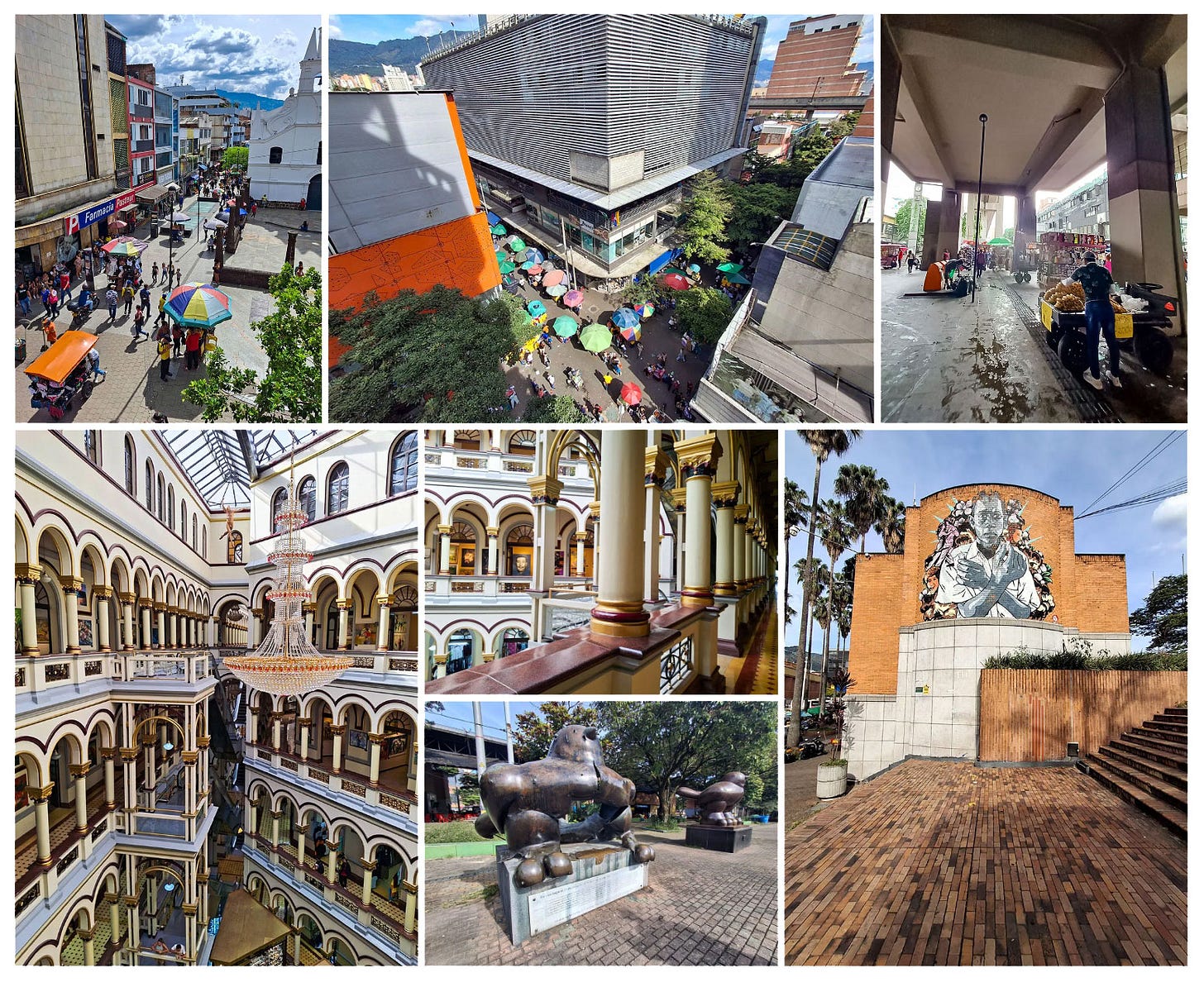
Comuna 13
Comuna 13 is one of the 16 comunas or sections of Medellín. It became famous for its violent history of fighting between Narcos, the military, and paramilitary groups and was once the most dangerous neighborhood in the city. In 2002, after a military operation to combat the crime, the area started to reverse its fortunes. Now, Comuna 13 is a safe and vibrant tourist center.
We did two tours of the neighborhood with Zippy Tour, one with Dian and another with Wayne. The history was fascinating. The tour ended at a giant hill stacked with homes, restaurants, bars, gift shops, and street performers accessed by several outdoor escalators. Colorful graffiti and murals adorned the walls. It was very touristy, but creativity abounded and I loved it.
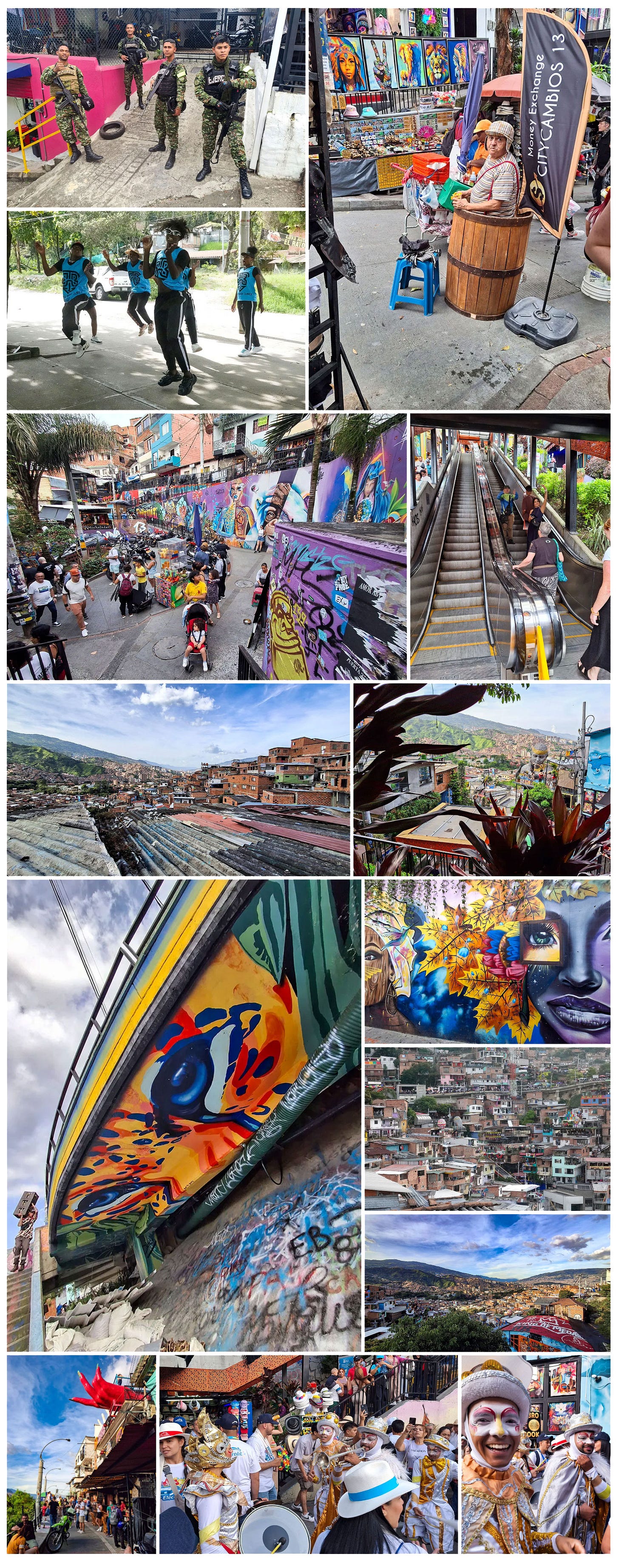
El Metrocable
The Metrocable is a cable car line, part of Medellín’s Metro transportation system. Six different routes take you up the mountains in a gondola to poorer neighborhoods inaccessible by other means of public transportation. Beginning operations in 2004, Medellín became the first city in the world to use this type of system as a full-time means of public transportation.
We took two rides on the Metrocable, one with Dian in the evening and one with Wayne the morning he left. We only got off to get right back on and descend back down the mountain. The system was well organized, and even on our evening trip when the line was long to board the gondolas, it moved faster than we expected. The view was excellent. We were amazed at how closely the cable cars passed over the roofs of the homes below.

El Poblado and Nearby Parks
We stayed in the El Poblado Comuna for our first 5 weeks and came back for our last 5 days. It is a trendy area with many restaurants, outdoor seating areas, nightlife, and parks. Almost every day we were there, we would wander through one of the many nearby parks. I loved the vibrancy of the neighborhood.
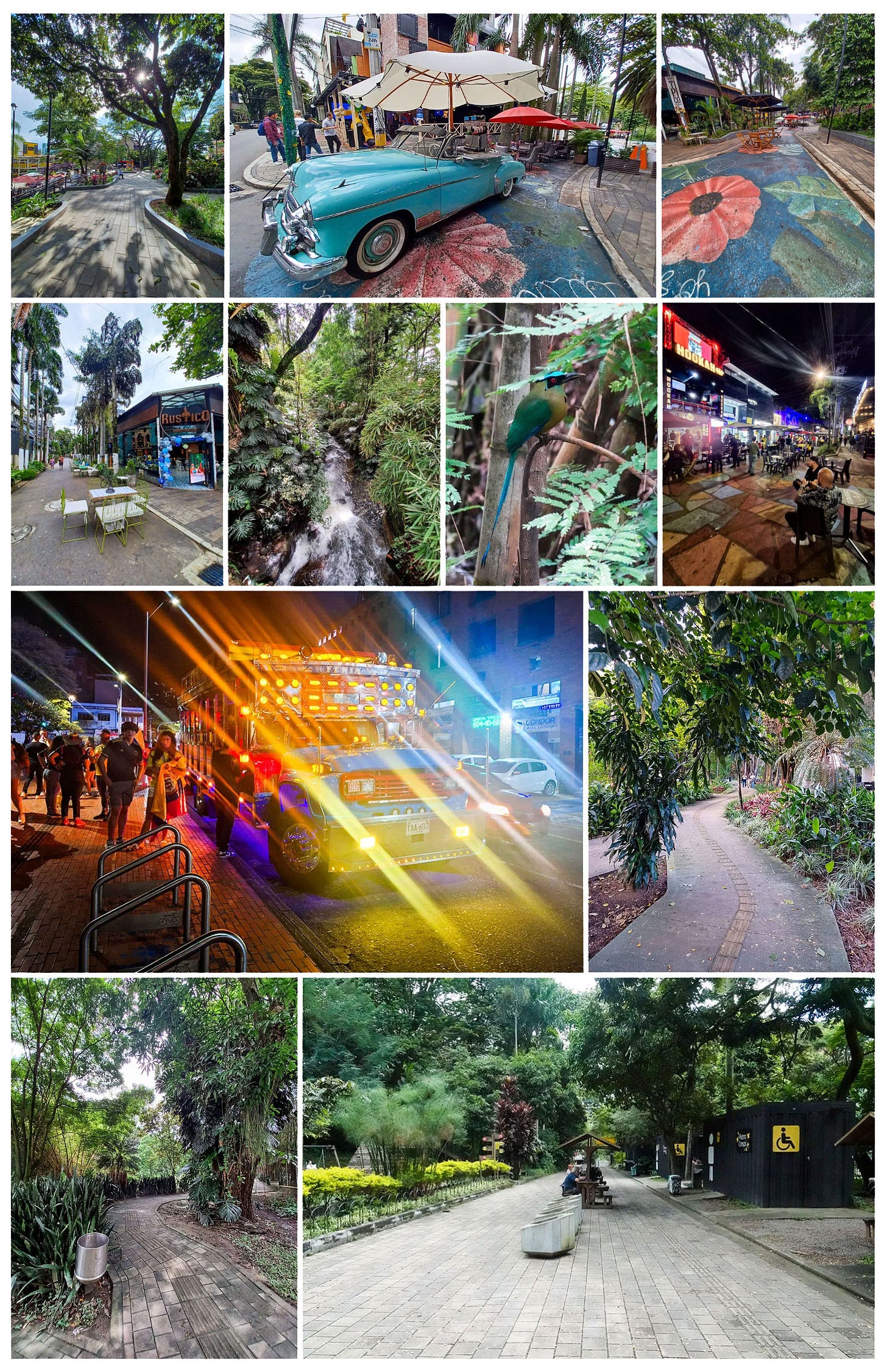
MAMM, Cemetery Museum, & Castle Museum
We visited a few other places with our friend Dian.
For five days, we lived right across the street from the Medellín Modern Art Museum (MAMM). MAMM has a permanent collection as well as rotating exhibitions and a movie theater. On weekends, the museum projects movies (or when Colombia was competing in the Copa America, fútbol games) on one of its exterior walls.

We attempted to visit the Jardín Botánico de Medellín but somehow hit it on the rare day that it was closed. I searched the map and noticed that Cementerio Museo San Pedro was nearby. This museum/cemetery is beautiful and I could have spent more time wandering around taking pictures, but we decided that it was time to leave when a funeral procession entered with wailing mourners.
Museo El Castillo is a bit unusual. It is a medieval Gothic-style Castle with French-style gardens. It was a private residence from the 1930s to 1971, when it became a museum. We did a tour of the interior, but unfortunately were not allowed to take pictures. The tour guide spoke Spanish in the rapid-fire monotone voice of someone who memorized the spiel but really didn’t care much about it. Nevertheless, it was interesting to visit.
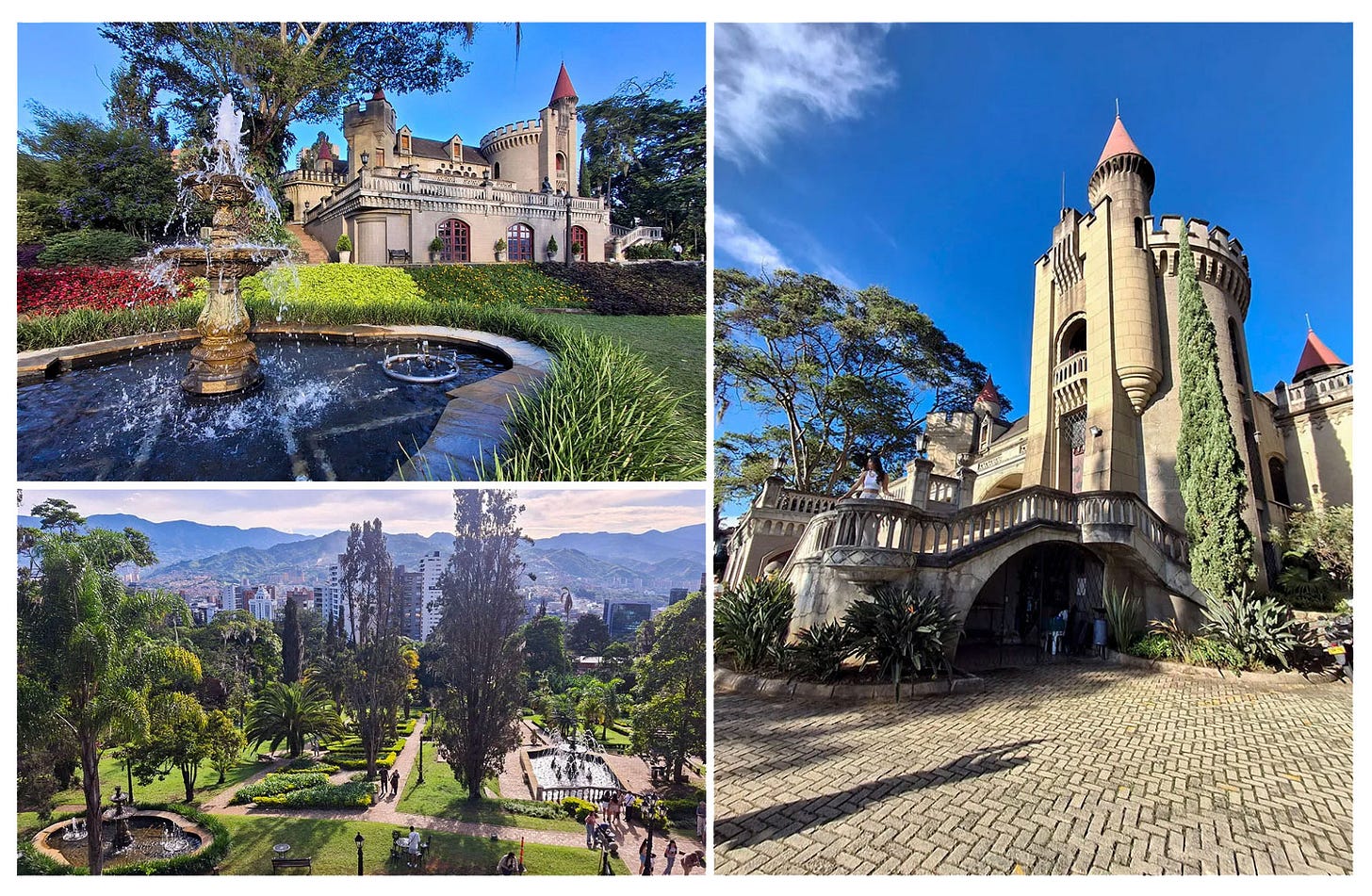
There was much more to see and do in Medellín, but our studies took precedence. We would have liked to have gone to Parque Arvi, experienced more neighborhoods, and visited more museums, nearby towns, and a coffee farm. Next time, perhaps….
Have you been to Medellín? What were your impresions? What did you like? What didn’t you like? Please leave a comment and let me know whatever this post inspires you to think about!




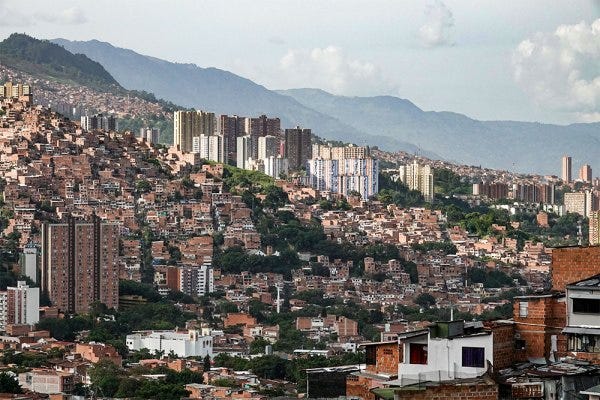
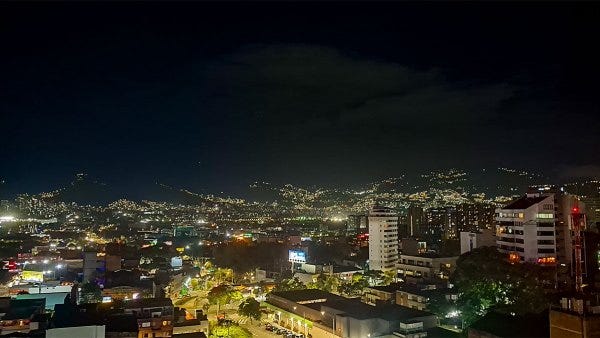
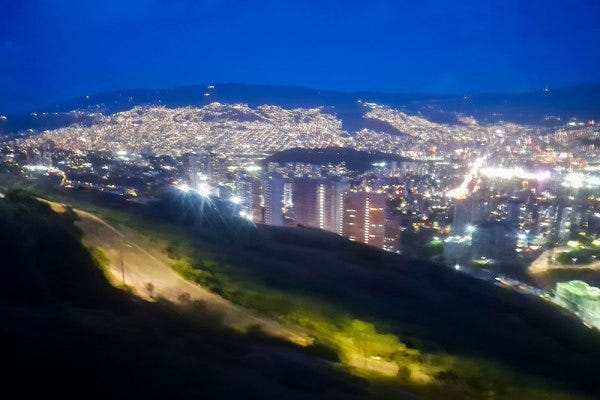

Great info and photos! Perhaps we will meet up on the road someday. We are meandering toward Ushuaia over the next several years.